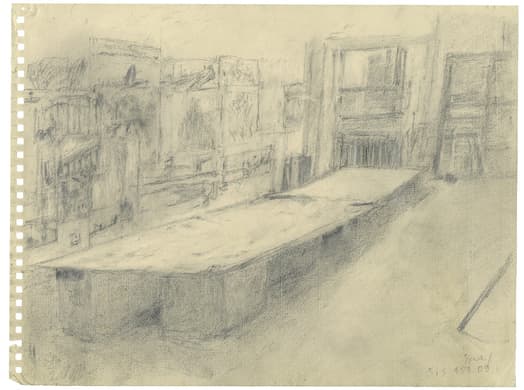Gallery-Going: The Head-Turning Depths of Everyday Objects
Betty Cuningham’s exhibition of Rackstraw Downes’s drawings includes more than 20 small, luminous sketches of his studio’s interior, nearly all dating from 2020.

Rackstraw Downes
Drawings
Betty Cuningham Gallery
Rackstraw Downes’s stature as one of today’s most important “realist” painters is secure, but perhaps we can be excused for thinking of him as also a brilliant poet/engineer.
During the past six decades, the paintings of the 82-year-old artist have combined, in unique fashion, a palette of quietly luminous color and an insistent drawing method that tends toward granular detail and wide-angle views. Having long ago discarded traditions of linear perspective and hierarchized forms, he records point-by-point the types of scenes that might seem unrecordable: landscapes, street scenes, and interiors so expansive they can be experienced only by turning the head.
His paintings are passive-aggressive, in a particularly rewarding way: They express, at once, the delight of innocent observation and the drive of an offbeat methodology.
Betty Cuningham’s exhibition of the artist’s drawings includes more than 20 small, luminous sketches of his studio’s interior, nearly all dating from 2020. Fleshing out the installation are nine earlier drawings — from as far back as 1975. Together they form a moving testament to a lifetime of looking, responding, and articulating.
Mr. Downes’s “uncompromising empiricism,” as he calls it, is amply evident in one of the earliest and largest works, a view of Upper West Side buildings and rooftops, ca. 1975. The drawing impresses for its sheer attention to detail; every tiny window, bit of building trim, and passing pedestrian has been carefully elaborated.
Yet this is no architectural study. For one thing, his deft tones — surely related to his paintings’ astute sense of color — register every shift of light across the vast number of surfaces, imparting to the scene a rich, atmospheric depth. His tireless eye and faith in first-hand observation also emerge in another, more telling way. His subject is too broad for a single, fixed glance, and he responds by subtly arcing the street below, and fanning out the buildings above. Unlike the regulated intervals of an architect’s rendering, Mr. Downes’s drawing unfolds before the eye, as would the scene in real life.
“I draw, not to establish anything, but to gain an acquaintance with a place,” Mr. Downes has claimed. The improvisational nature of his approach — despite the meticulous detail — is confirmed, on close inspection, by the way many drawings have been extended with additional pieces of paper. Among them an early, very horizontal drawing from 1986 — its width fully five times its height — ingeniously conveys the effect of 180-degree view of a single street in Galveston, Texas. The viewer tangibly feels the turning of the head necessary to absorb the multiple buildings and palm trees, whose overlapping and diminishing forms accelerate toward either edge. Supporting them all is the quivering stretch of the roadway itself.
Vertical extensions also intrigue the artist, and several drawings from 2006 of enclosed spaces — a barn, a studio, the space beneath an elevated subway track — express a different version of contained vastness, turning overhead views into great canopies of arcing, crisscrossing beams.
The first drawings to greet the galley-goer are the nearly two-dozen that almost all date from 2020. Although more intimate in subject matter and scale, and somewhat softer in line, they reflect the same urge to locate — and so characterize — everyday objects in a vitalizing space.
Has the artist’s approach evolved over the many years? It may just be that he has become more inclined to allow objects to emerge in their own time; as chairs, tables, and French easels commune in the light-filled space, they seem situated less by topological or volumetric logic than by the very workings of light — the enclosing, suffusing force that animates a shadowed leg here, a reflecting portion of floor there. The dramatic, eye-chaperoning energy of the earlier drawings is still there, but is now subtler and more organic.
The effect is magical in a drawing like “In the Artist’s Studio XVII,” which combines resolve and contemplation in equal measure. Here, two long tables, placed end to end, push through the studio space, their tops hovering in their lightness above soft, deep shadow. In a second, more austere version, the wall behind the table recedes blankly, making way for another experience: a series of chair backs, their dark forms barely poking above the tables, spelling out the full depth of the studio.
Other drawings capture easels, metal folding chairs, and a heavy, thin table, clustered about 20 feet before a wall of sunlit windows. Intervals of light and space proliferate, almost crazily, but Mr. Downes’s astute tones, and especially his rhythmic ordering, make everything clear.
At points, the drawings remind the viewer somewhat of the work of James Castle (1899-1977), the deaf-mute “outsider” artist who spent decades drawing scenes of his family’s Idaho farm. Both artists’ drawings enclose everyday objects within a mysterious, abiding silence. Both use understated means to flesh out their subjects with apparently infinite patience. But unlike Castle’s drawings, in Mr. Downes’s we sense the practical, personal repercussions of the moment. Perhaps most poignantly, amongst all the studio paraphernalia, the artist’s own walker and cane make occasional, matter-of-fact appearances.
It’s impossible to avoid reading ourselves into another pair of drawings, each featuring two dark wooden chairs in the foreground, silhouetted by the bright expanse of the studio beyond. The extent of the space is measured out, table by chair, garbage can by box, until we reach the distant, luminous wall of windows. We, of course, could be the chairs themselves — taking in the whole spectacle, wondering at its fullness, and grateful for the moment.
Until March 19 (15 Rivington St., between Bowery and Chrystie Street, 212-242-2772, www.bettycuninghamgallery.com)

